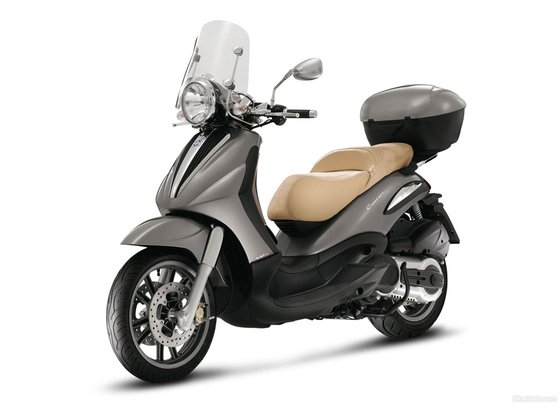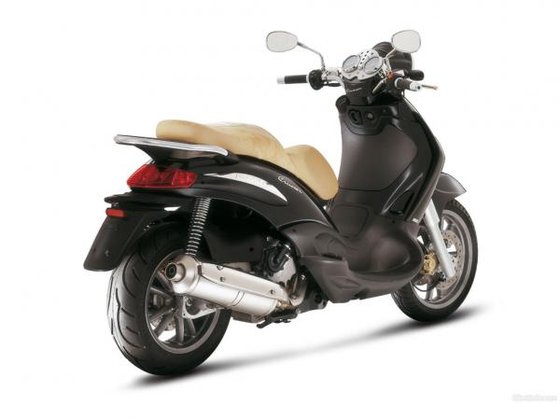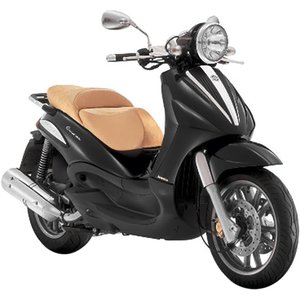Piaggio Beverly 500 [2003 – 2012] Review: The Maxi-Scooter That Balances Urban Agility and Touring Potential

Introduction
The Piaggio Beverly 500 is a scooter that defies easy categorization. Produced from 2003 to 2012, this maxi-scooter generation carved out a niche as a stylish, versatile machine capable of threading through city traffic with ease while still offering enough grunt for weekend escapes. With its single-cylinder engine, Euro-chic design, and surprising highway competence, the Beverly 500 remains a compelling choice for riders who want practicality without sacrificing personality. After spending time with a well-maintained 2011 BV Tourer 500 variant, here’s why this Piaggio deserves a closer look—and how it holds up against its rivals.
Design: Italian Flair Meets Functional Pragmatism

The Beverly’s design language screams Mediterranean sophistication. Its clean lines, chrome accents, and sculpted bodywork give it a premium feel that stands out in a sea of plasticky commuter scooters. The 2011 Tourer model I tested featured a sleek white finish with contrasting black trim, but earlier carbureted versions (2003–2006) came in bolder options like Graphite Black and Sienna Ivory.
Piaggio’s attention to detail shines in elements like the integrated LED taillights and the minimalist dashboard (a mix of analog and digital displays in later models). However, not all design choices hit the mark. The optional windscreen—a common add-on for touring—draws criticism for its bulky, tacked-on appearance. One rider aptly compared it to a “wart” disrupting the scooter’s otherwise cohesive aesthetics. Still, the overall package feels upscale, especially with alloy wheels and dual front disc brakes adding a sporty edge.
Engine and Performance: Single-Cylinder Heart with Dual Personalities

At its core, the Beverly 500 relies on Piaggio’s proven “Master” engine—a liquid-cooled, four-stroke single-cylinder powerplant. Displacement varied slightly across generations:
- Early models (2003–2006): 459 cc carbureted engine producing 39 HP (29 kW).
- Later models (2007–2012): 492 cc fuel-injected version with the same peak power but smoother delivery.
The fuel-injected 492 cc variant I rode delivered linear acceleration, hitting 0–60 km/h (0–37 mph) in 4.5 seconds—respectable for a 189 kg (416 lbs) scooter. Top speed is quoted at 129–160 km/h (80–99 mph), depending on model year and gearing. Realistically, expect a comfortable 110–130 km/h (68–81 mph) cruise on highways, with vibrations becoming noticeable above 120 km/h (75 mph).
Torque peaks at 43 Nm (31.7 lb-ft) @ 5500 RPM, giving the Beverly enough low-end grunt to dart through traffic. The CVT transmission is seamless, though purists might miss the engagement of a manual gearbox. Fuel economy sits around 4.06 L/100 km (57.9 mpg), translating to a 330–350 km (205–217 mi) range from its 13.2L (3.5-gallon) tank—a boon for touring.
Ride and Handling: City Nimble, Highway Stable
The Beverly’s chassis combines a steel tube frame with a 1549 mm (61-inch) wheelbase, striking a balance between agility and stability. Front suspension uses 41 mm telescopic forks, while the rear employs dual preload-adjustable shocks. Wheel sizes (110/70-16 front, 140/70-14 rear) contribute to its confident cornering, though the smaller rear wheel can feel twitchy compared to rivals like the Aprilia Scarabeo 500’s 16-inch setup.
Where the Beverly shines is braking. Later models feature 260 mm front discs with twin-piston Brembo calipers and a linked braking system (LBS) that intelligently distributes force between wheels. Stops from 100 km/h (62 mph) are reassuringly firm, outperforming the Scarabeo’s softer setup. Tire pressures (2.2 bar front/2.2–2.3 bar rear) are critical here—underinflate, and the handling turns vague.
Comfort and Ergonomics: All-Day Riding with Caveats
With a 775–780 mm (30.5–30.7-inch) seat height, the Beverly accommodates shorter riders while still offering ample legroom. The wide, well-padded seat is a highlight—I logged 200 km (124 mi) in a day without soreness. Wind protection is a mixed bag: the standard flyscreen is decorative, forcing riders to opt for that divisive tall windscreen for highway comfort.
Storage is adequate, with under-seat space fitting a full-face helmet (Piaggio claims 35L capacity). Optional top cases and leg-cover compartments add utility. The analog-digital dash is legible but lacks modern touches like smartphone connectivity—a reminder of the Beverly’s pre-2012 origins.
Competition: How the Beverly Stacks Up
1. Aprilia Scarabeo 500
The Beverly’s closest cousin shares its engine but prioritizes touring comfort. The Scarabeo’s longer windscreen, lower seat (800 mm / 31.5 inches), and 16-inch rear wheel make it steadier at speed. However, its 220 kg (485 lbs) weight dulls acceleration, and its brakes feel spongy compared to the Piaggio’s Brembos.
2. Yamaha TMAX 500
Yamaha’s sportier rival counters with a parallel-twin engine, sharper handling, and premium features. But the TMAX costs significantly more used and lacks the Beverly’s retro charm. Maintenance is also costlier.
3. BMW C 400 GT
A modern contender, the C 400 GT offers tech like traction control and a TFT display. Yet its 350 cc engine can’t match the Beverly’s highway confidence. The Piaggio wins for simplicity and aftermarket support.
Verdict: The Beverly 500 isn’t the fastest or most refined maxi-scooter, but its blend of style, braking performance, and mechanical simplicity gives it enduring appeal.
Maintenance: Keeping Your Beverly in Prime Shape
The Beverly 500 is relatively low-maintenance, but attention to these areas will ensure longevity:
1. Engine Oil
Use SAE 5W-40 synthetic (1.5L with filter). Change every 6,000 km (3,700 mi). Ignoring this risks sludge buildup in the liquid-cooled engine.
2. Valve Adjustments
Check valve clearance every 12,000 km (7,500 mi). Both intake and exhaust valves require 0.15 mm (0.006 in) when cold—a precise but DIY-friendly job with shims.
3. Belt Drive
Later models use a belt final drive. Inspect for cracks every 10,000 km (6,200 mi) and replace every 25,000 km (15,500 mi). MOTOPARTS.store stocks OEM-spec belts for smooth power delivery.
4. Brake Fluid
Flush DOT 4 fluid every two years. The linked braking system is sensitive to moisture contamination.
5. Cooling System
Drain and refill coolant (1.7L water/ethylene glycol mix) every 24,000 km (15,000 mi). Overheating is rare but costly.
Pro Tip:
The Beverly’s NGK CR7EIX iridium spark plugs last longer than standard copper plugs—upgrade if yours still uses CR7EKB.
Conclusion: A Timeless Urban Companion
The Piaggio Beverly 500 isn’t perfect. Its windscreen options divide opinion, its vibrations irk at high RPMs, and its tech feels dated next to 2020s scooters. Yet, it excels where it matters: delivering a ride that’s engaging enough for enthusiasts and practical enough for daily commuters. Whether filtering through Rome’s traffic or exploring coastal roads, the Beverly proves that maxi-scooters needn’t sacrifice soul for utility.
For owners looking to refresh their Beverly, MOTOPARTS.store offers everything from performance brake pads to retro-inspired accessories—ensuring this Italian classic ages as gracefully as it rides.



















